Project Quality Management in Global Teams: A Detailed Report
VerifiedAdded on 2020/04/07
|14
|3456
|251
Report
AI Summary
This report provides a comprehensive overview of project quality management, emphasizing its critical role in ensuring project success. It defines project quality management as the application of various skills, tools, and techniques to guarantee project completion within specified constraints. The report outlines the four key components of project quality management: quality planning, quality assurance, quality control, and quality improvement, detailing their significance and application. It also delves into the challenges faced by global project teams, including cultural differences, technological disparities, geographical boundaries, management variations, and legal complexities. Furthermore, the report proposes remedies to these challenges, such as culture recognition, effective time zone navigation, and strong leadership. The report underscores the importance of a well-defined quality management plan and effective communication within global teams to achieve project objectives and maintain high-quality standards.
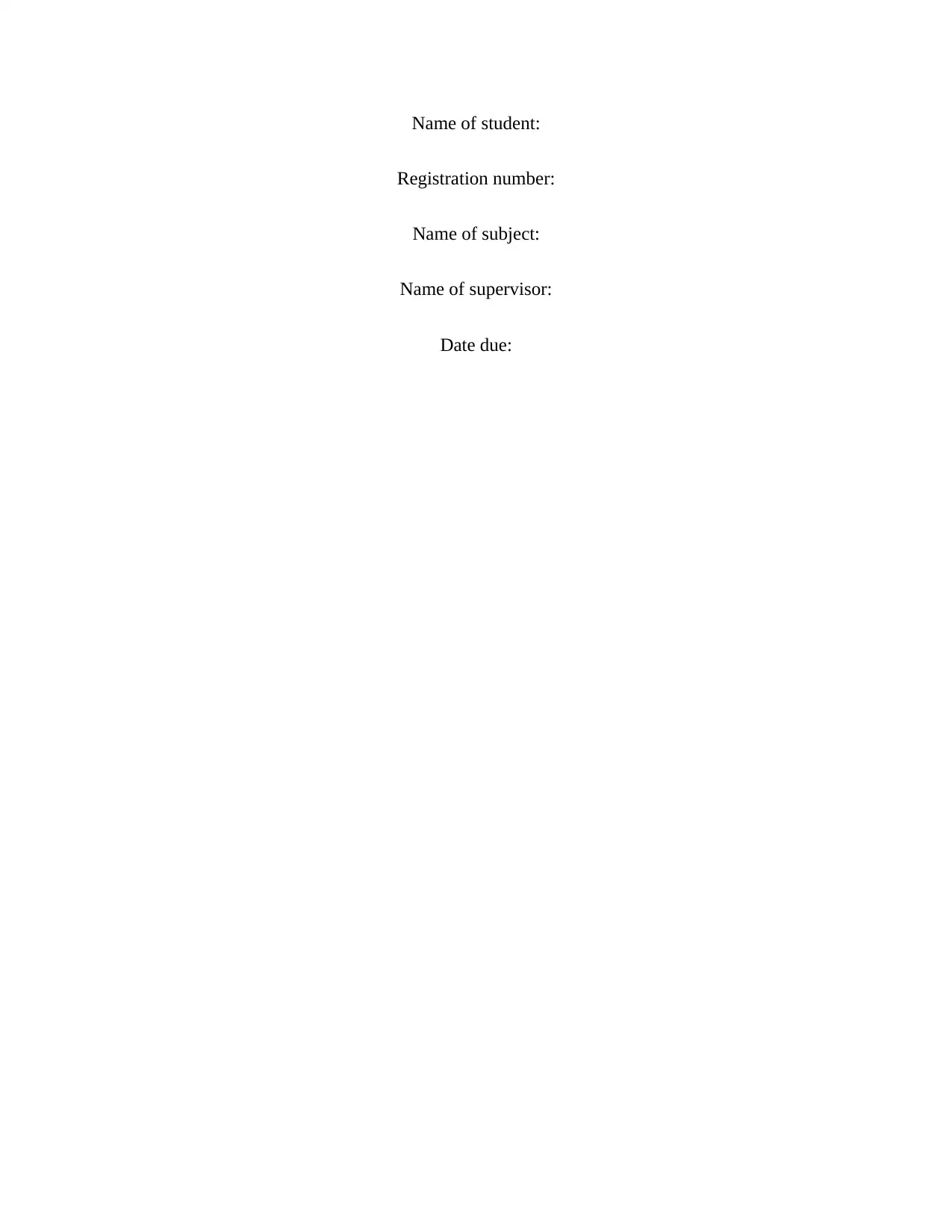
Name of student:
Registration number:
Name of subject:
Name of supervisor:
Date due:
Registration number:
Name of subject:
Name of supervisor:
Date due:
Paraphrase This Document
Need a fresh take? Get an instant paraphrase of this document with our AI Paraphraser
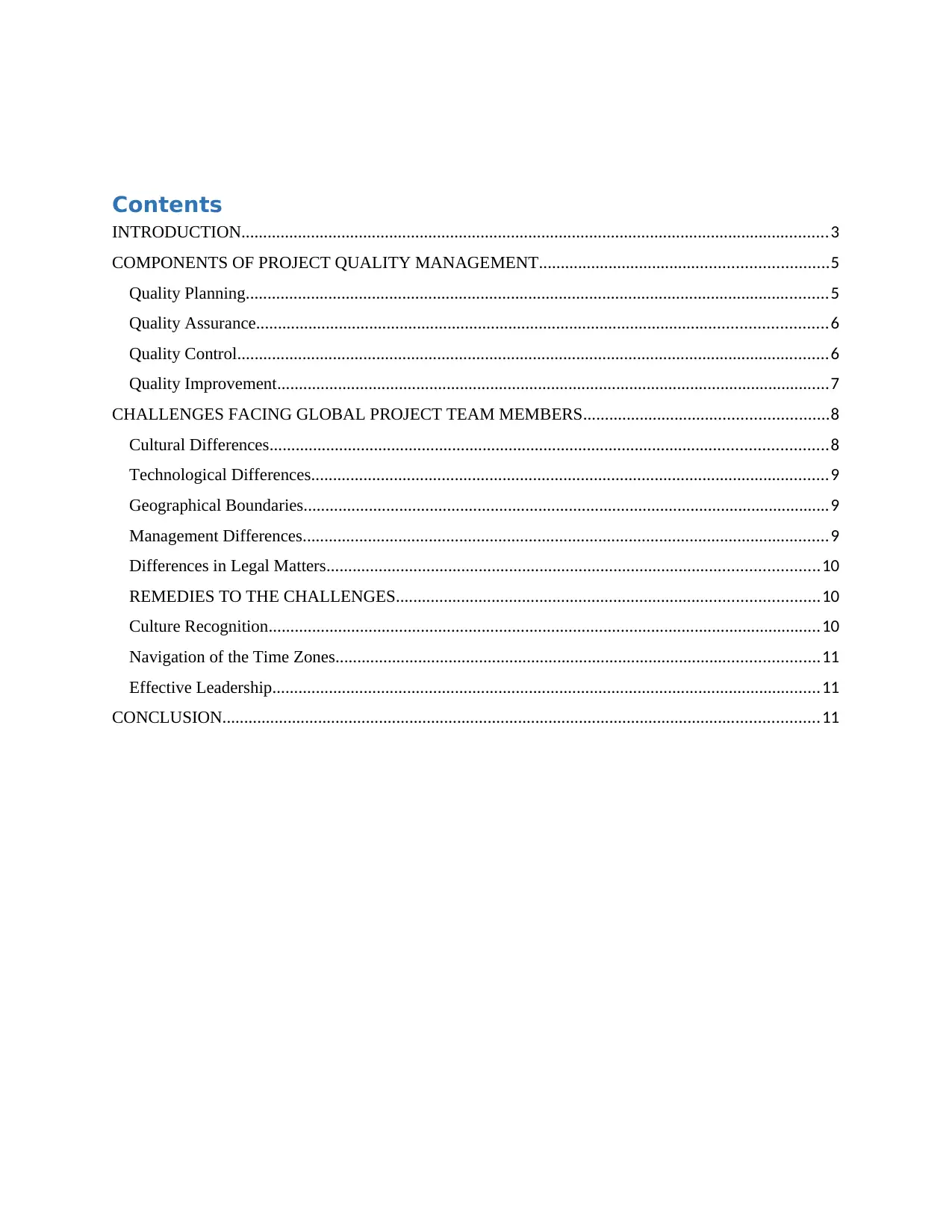
Contents
INTRODUCTION.......................................................................................................................................3
COMPONENTS OF PROJECT QUALITY MANAGEMENT..................................................................5
Quality Planning......................................................................................................................................5
Quality Assurance...................................................................................................................................6
Quality Control........................................................................................................................................6
Quality Improvement...............................................................................................................................7
CHALLENGES FACING GLOBAL PROJECT TEAM MEMBERS........................................................8
Cultural Differences................................................................................................................................8
Technological Differences.......................................................................................................................9
Geographical Boundaries.........................................................................................................................9
Management Differences.........................................................................................................................9
Differences in Legal Matters.................................................................................................................10
REMEDIES TO THE CHALLENGES.................................................................................................10
Culture Recognition...............................................................................................................................10
Navigation of the Time Zones...............................................................................................................11
Effective Leadership..............................................................................................................................11
CONCLUSION.........................................................................................................................................11
INTRODUCTION.......................................................................................................................................3
COMPONENTS OF PROJECT QUALITY MANAGEMENT..................................................................5
Quality Planning......................................................................................................................................5
Quality Assurance...................................................................................................................................6
Quality Control........................................................................................................................................6
Quality Improvement...............................................................................................................................7
CHALLENGES FACING GLOBAL PROJECT TEAM MEMBERS........................................................8
Cultural Differences................................................................................................................................8
Technological Differences.......................................................................................................................9
Geographical Boundaries.........................................................................................................................9
Management Differences.........................................................................................................................9
Differences in Legal Matters.................................................................................................................10
REMEDIES TO THE CHALLENGES.................................................................................................10
Culture Recognition...............................................................................................................................10
Navigation of the Time Zones...............................................................................................................11
Effective Leadership..............................................................................................................................11
CONCLUSION.........................................................................................................................................11
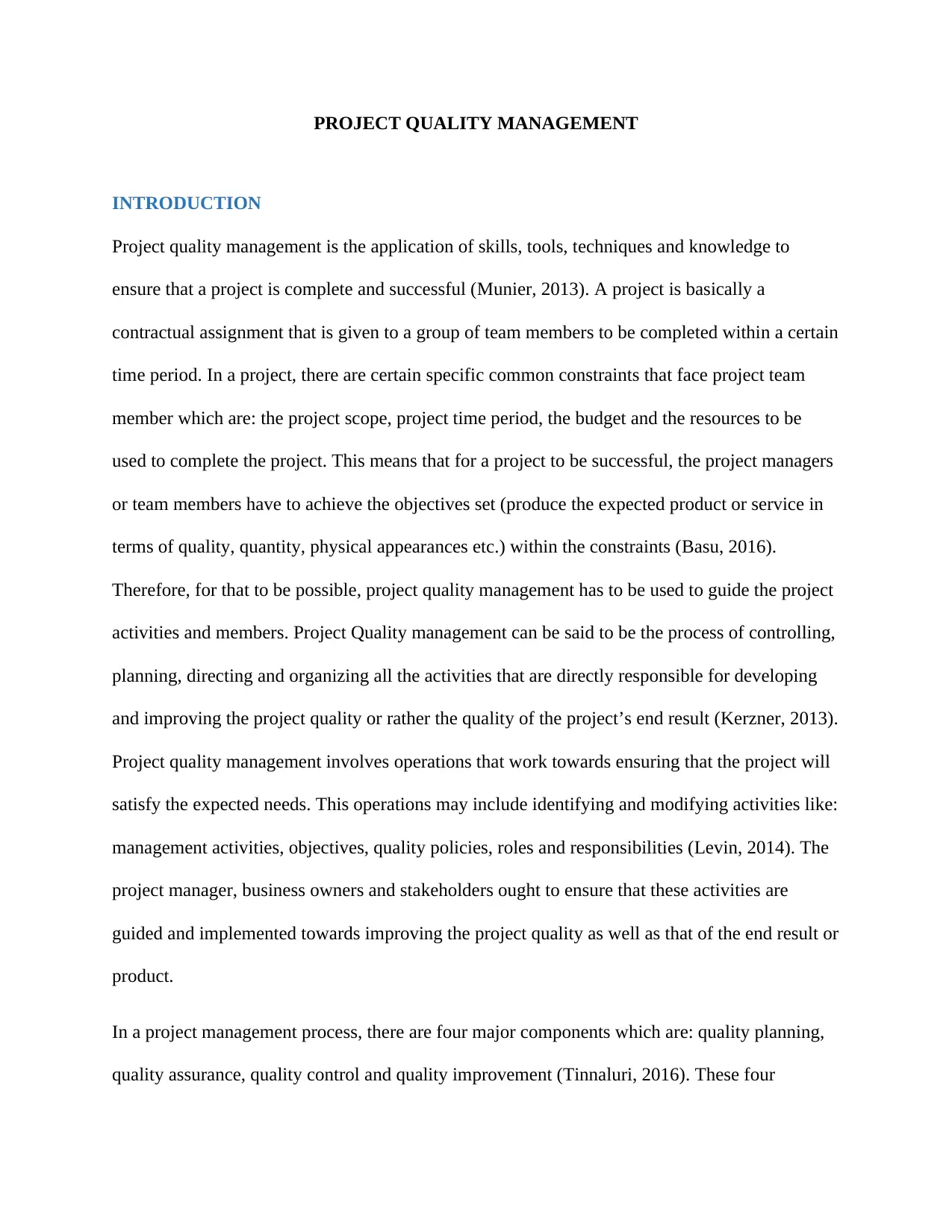
PROJECT QUALITY MANAGEMENT
INTRODUCTION
Project quality management is the application of skills, tools, techniques and knowledge to
ensure that a project is complete and successful (Munier, 2013). A project is basically a
contractual assignment that is given to a group of team members to be completed within a certain
time period. In a project, there are certain specific common constraints that face project team
member which are: the project scope, project time period, the budget and the resources to be
used to complete the project. This means that for a project to be successful, the project managers
or team members have to achieve the objectives set (produce the expected product or service in
terms of quality, quantity, physical appearances etc.) within the constraints (Basu, 2016).
Therefore, for that to be possible, project quality management has to be used to guide the project
activities and members. Project Quality management can be said to be the process of controlling,
planning, directing and organizing all the activities that are directly responsible for developing
and improving the project quality or rather the quality of the project’s end result (Kerzner, 2013).
Project quality management involves operations that work towards ensuring that the project will
satisfy the expected needs. This operations may include identifying and modifying activities like:
management activities, objectives, quality policies, roles and responsibilities (Levin, 2014). The
project manager, business owners and stakeholders ought to ensure that these activities are
guided and implemented towards improving the project quality as well as that of the end result or
product.
In a project management process, there are four major components which are: quality planning,
quality assurance, quality control and quality improvement (Tinnaluri, 2016). These four
INTRODUCTION
Project quality management is the application of skills, tools, techniques and knowledge to
ensure that a project is complete and successful (Munier, 2013). A project is basically a
contractual assignment that is given to a group of team members to be completed within a certain
time period. In a project, there are certain specific common constraints that face project team
member which are: the project scope, project time period, the budget and the resources to be
used to complete the project. This means that for a project to be successful, the project managers
or team members have to achieve the objectives set (produce the expected product or service in
terms of quality, quantity, physical appearances etc.) within the constraints (Basu, 2016).
Therefore, for that to be possible, project quality management has to be used to guide the project
activities and members. Project Quality management can be said to be the process of controlling,
planning, directing and organizing all the activities that are directly responsible for developing
and improving the project quality or rather the quality of the project’s end result (Kerzner, 2013).
Project quality management involves operations that work towards ensuring that the project will
satisfy the expected needs. This operations may include identifying and modifying activities like:
management activities, objectives, quality policies, roles and responsibilities (Levin, 2014). The
project manager, business owners and stakeholders ought to ensure that these activities are
guided and implemented towards improving the project quality as well as that of the end result or
product.
In a project management process, there are four major components which are: quality planning,
quality assurance, quality control and quality improvement (Tinnaluri, 2016). These four
⊘ This is a preview!⊘
Do you want full access?
Subscribe today to unlock all pages.

Trusted by 1+ million students worldwide
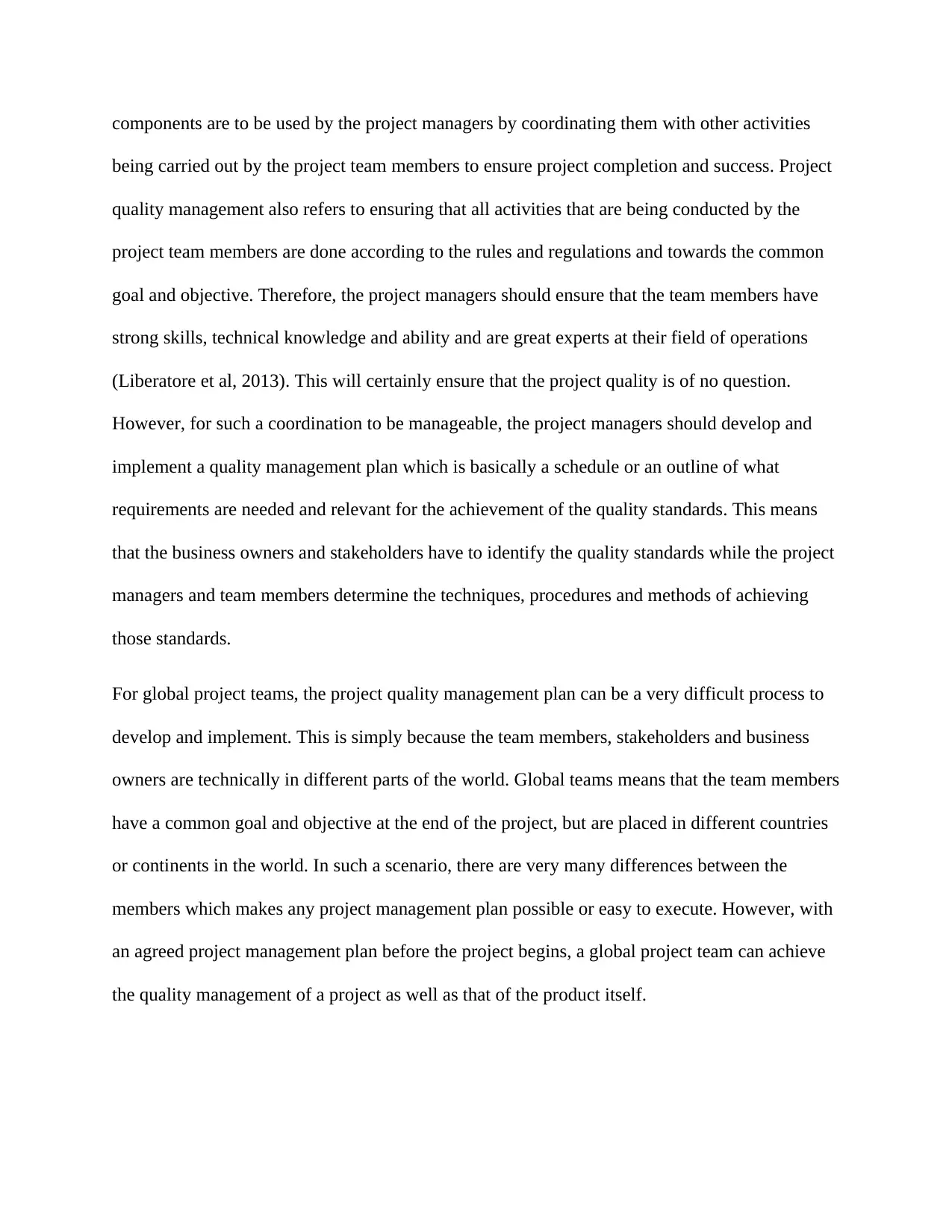
components are to be used by the project managers by coordinating them with other activities
being carried out by the project team members to ensure project completion and success. Project
quality management also refers to ensuring that all activities that are being conducted by the
project team members are done according to the rules and regulations and towards the common
goal and objective. Therefore, the project managers should ensure that the team members have
strong skills, technical knowledge and ability and are great experts at their field of operations
(Liberatore et al, 2013). This will certainly ensure that the project quality is of no question.
However, for such a coordination to be manageable, the project managers should develop and
implement a quality management plan which is basically a schedule or an outline of what
requirements are needed and relevant for the achievement of the quality standards. This means
that the business owners and stakeholders have to identify the quality standards while the project
managers and team members determine the techniques, procedures and methods of achieving
those standards.
For global project teams, the project quality management plan can be a very difficult process to
develop and implement. This is simply because the team members, stakeholders and business
owners are technically in different parts of the world. Global teams means that the team members
have a common goal and objective at the end of the project, but are placed in different countries
or continents in the world. In such a scenario, there are very many differences between the
members which makes any project management plan possible or easy to execute. However, with
an agreed project management plan before the project begins, a global project team can achieve
the quality management of a project as well as that of the product itself.
being carried out by the project team members to ensure project completion and success. Project
quality management also refers to ensuring that all activities that are being conducted by the
project team members are done according to the rules and regulations and towards the common
goal and objective. Therefore, the project managers should ensure that the team members have
strong skills, technical knowledge and ability and are great experts at their field of operations
(Liberatore et al, 2013). This will certainly ensure that the project quality is of no question.
However, for such a coordination to be manageable, the project managers should develop and
implement a quality management plan which is basically a schedule or an outline of what
requirements are needed and relevant for the achievement of the quality standards. This means
that the business owners and stakeholders have to identify the quality standards while the project
managers and team members determine the techniques, procedures and methods of achieving
those standards.
For global project teams, the project quality management plan can be a very difficult process to
develop and implement. This is simply because the team members, stakeholders and business
owners are technically in different parts of the world. Global teams means that the team members
have a common goal and objective at the end of the project, but are placed in different countries
or continents in the world. In such a scenario, there are very many differences between the
members which makes any project management plan possible or easy to execute. However, with
an agreed project management plan before the project begins, a global project team can achieve
the quality management of a project as well as that of the product itself.
Paraphrase This Document
Need a fresh take? Get an instant paraphrase of this document with our AI Paraphraser
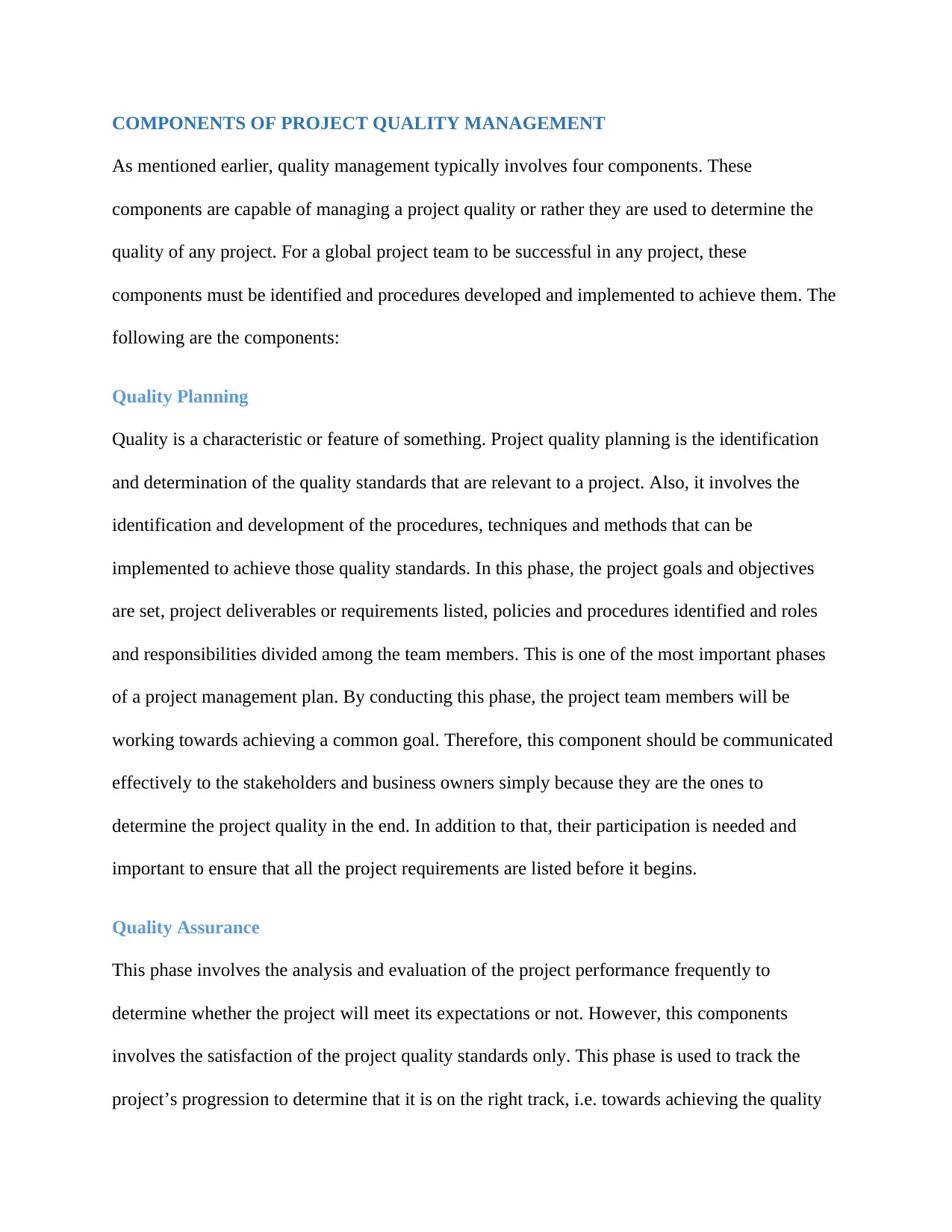
COMPONENTS OF PROJECT QUALITY MANAGEMENT
As mentioned earlier, quality management typically involves four components. These
components are capable of managing a project quality or rather they are used to determine the
quality of any project. For a global project team to be successful in any project, these
components must be identified and procedures developed and implemented to achieve them. The
following are the components:
Quality Planning
Quality is a characteristic or feature of something. Project quality planning is the identification
and determination of the quality standards that are relevant to a project. Also, it involves the
identification and development of the procedures, techniques and methods that can be
implemented to achieve those quality standards. In this phase, the project goals and objectives
are set, project deliverables or requirements listed, policies and procedures identified and roles
and responsibilities divided among the team members. This is one of the most important phases
of a project management plan. By conducting this phase, the project team members will be
working towards achieving a common goal. Therefore, this component should be communicated
effectively to the stakeholders and business owners simply because they are the ones to
determine the project quality in the end. In addition to that, their participation is needed and
important to ensure that all the project requirements are listed before it begins.
Quality Assurance
This phase involves the analysis and evaluation of the project performance frequently to
determine whether the project will meet its expectations or not. However, this components
involves the satisfaction of the project quality standards only. This phase is used to track the
project’s progression to determine that it is on the right track, i.e. towards achieving the quality
As mentioned earlier, quality management typically involves four components. These
components are capable of managing a project quality or rather they are used to determine the
quality of any project. For a global project team to be successful in any project, these
components must be identified and procedures developed and implemented to achieve them. The
following are the components:
Quality Planning
Quality is a characteristic or feature of something. Project quality planning is the identification
and determination of the quality standards that are relevant to a project. Also, it involves the
identification and development of the procedures, techniques and methods that can be
implemented to achieve those quality standards. In this phase, the project goals and objectives
are set, project deliverables or requirements listed, policies and procedures identified and roles
and responsibilities divided among the team members. This is one of the most important phases
of a project management plan. By conducting this phase, the project team members will be
working towards achieving a common goal. Therefore, this component should be communicated
effectively to the stakeholders and business owners simply because they are the ones to
determine the project quality in the end. In addition to that, their participation is needed and
important to ensure that all the project requirements are listed before it begins.
Quality Assurance
This phase involves the analysis and evaluation of the project performance frequently to
determine whether the project will meet its expectations or not. However, this components
involves the satisfaction of the project quality standards only. This phase is used to track the
project’s progression to determine that it is on the right track, i.e. towards achieving the quality
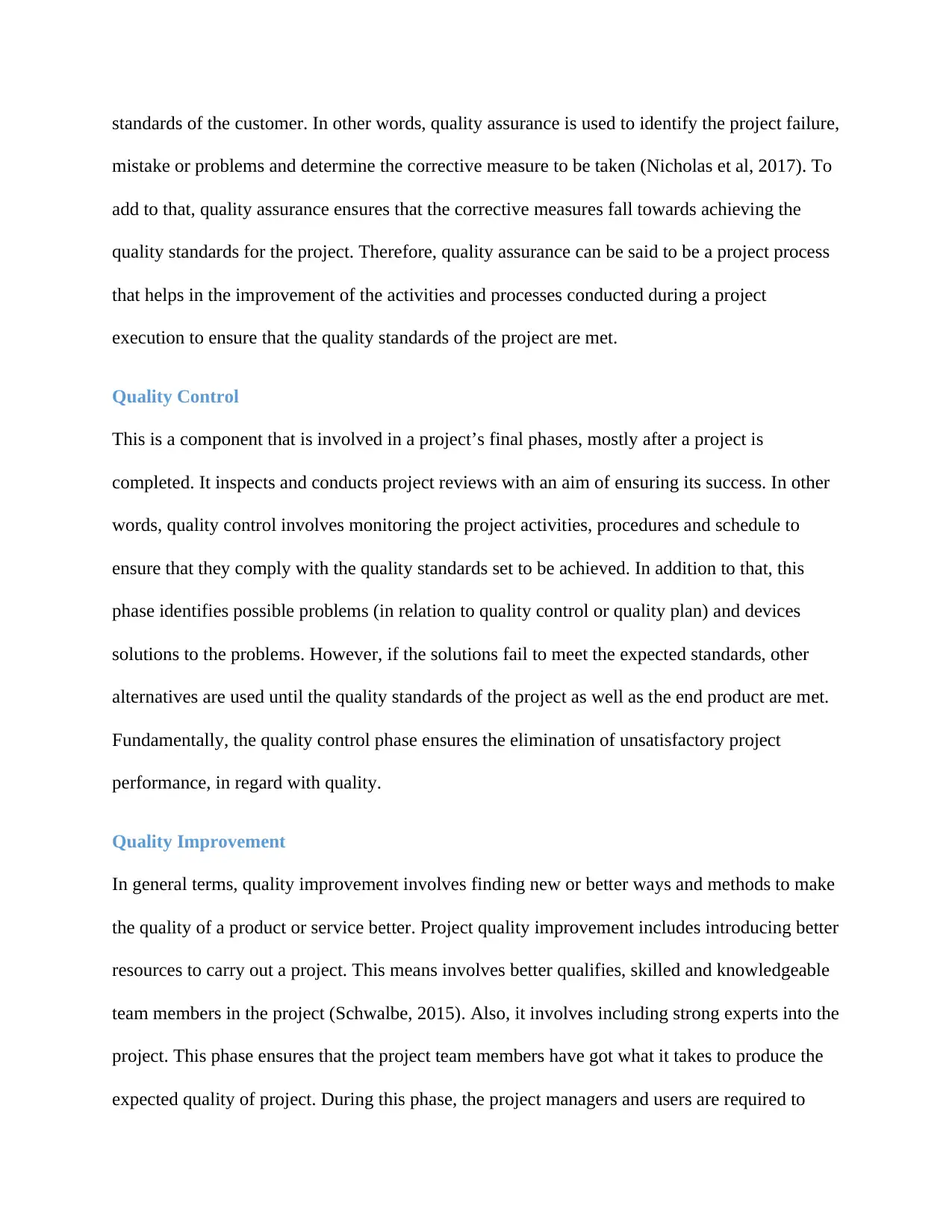
standards of the customer. In other words, quality assurance is used to identify the project failure,
mistake or problems and determine the corrective measure to be taken (Nicholas et al, 2017). To
add to that, quality assurance ensures that the corrective measures fall towards achieving the
quality standards for the project. Therefore, quality assurance can be said to be a project process
that helps in the improvement of the activities and processes conducted during a project
execution to ensure that the quality standards of the project are met.
Quality Control
This is a component that is involved in a project’s final phases, mostly after a project is
completed. It inspects and conducts project reviews with an aim of ensuring its success. In other
words, quality control involves monitoring the project activities, procedures and schedule to
ensure that they comply with the quality standards set to be achieved. In addition to that, this
phase identifies possible problems (in relation to quality control or quality plan) and devices
solutions to the problems. However, if the solutions fail to meet the expected standards, other
alternatives are used until the quality standards of the project as well as the end product are met.
Fundamentally, the quality control phase ensures the elimination of unsatisfactory project
performance, in regard with quality.
Quality Improvement
In general terms, quality improvement involves finding new or better ways and methods to make
the quality of a product or service better. Project quality improvement includes introducing better
resources to carry out a project. This means involves better qualifies, skilled and knowledgeable
team members in the project (Schwalbe, 2015). Also, it involves including strong experts into the
project. This phase ensures that the project team members have got what it takes to produce the
expected quality of project. During this phase, the project managers and users are required to
mistake or problems and determine the corrective measure to be taken (Nicholas et al, 2017). To
add to that, quality assurance ensures that the corrective measures fall towards achieving the
quality standards for the project. Therefore, quality assurance can be said to be a project process
that helps in the improvement of the activities and processes conducted during a project
execution to ensure that the quality standards of the project are met.
Quality Control
This is a component that is involved in a project’s final phases, mostly after a project is
completed. It inspects and conducts project reviews with an aim of ensuring its success. In other
words, quality control involves monitoring the project activities, procedures and schedule to
ensure that they comply with the quality standards set to be achieved. In addition to that, this
phase identifies possible problems (in relation to quality control or quality plan) and devices
solutions to the problems. However, if the solutions fail to meet the expected standards, other
alternatives are used until the quality standards of the project as well as the end product are met.
Fundamentally, the quality control phase ensures the elimination of unsatisfactory project
performance, in regard with quality.
Quality Improvement
In general terms, quality improvement involves finding new or better ways and methods to make
the quality of a product or service better. Project quality improvement includes introducing better
resources to carry out a project. This means involves better qualifies, skilled and knowledgeable
team members in the project (Schwalbe, 2015). Also, it involves including strong experts into the
project. This phase ensures that the project team members have got what it takes to produce the
expected quality of project. During this phase, the project managers and users are required to
⊘ This is a preview!⊘
Do you want full access?
Subscribe today to unlock all pages.

Trusted by 1+ million students worldwide

interact with other project managers with an aim of learning anything that can improve the
quality of the project in any way. However, this will limit the people involved only to quality
related information. According to Simona et al, 2011, this is a component that is fundamental in
a global project members because they are all required to participate and share any information
or knowledge that can improve the quality of a project. On the other hand, it can be a very
beneficial aspect because in a global team, different people with different views and knowledge
on quality are involved.
For a global team to achieve project quality management, they must work together in creating an
effective and efficient quality management plan to use during the project implementation. This
simply means that the business owners, stakeholder, project managers and the other project team
members have to rely on each other for information and support. Furthermore, they all have to let
go the differences between them to achieve the expected quality standards of the project.
However, they have to need to ensure that all the components listed above are identified and
procedures for their achievement determined (Alami, 2016). There are challenges that face
global project team members that should also be identified.
CHALLENGES FACING GLOBAL PROJECT TEAM MEMBERS
Cultural Differences
In a global project, the management of any project becomes a difficult task for the project
managers because of the cultural differences among the members. Due to these differences, there
are additional challenges, e.g. with communication. The different attitudes and behaviors caused
by cultural differences increase the possibility of problems arising during the project executing.
Furthermore, the cultural diversities increases the possibilities of project failure which is caused
quality of the project in any way. However, this will limit the people involved only to quality
related information. According to Simona et al, 2011, this is a component that is fundamental in
a global project members because they are all required to participate and share any information
or knowledge that can improve the quality of a project. On the other hand, it can be a very
beneficial aspect because in a global team, different people with different views and knowledge
on quality are involved.
For a global team to achieve project quality management, they must work together in creating an
effective and efficient quality management plan to use during the project implementation. This
simply means that the business owners, stakeholder, project managers and the other project team
members have to rely on each other for information and support. Furthermore, they all have to let
go the differences between them to achieve the expected quality standards of the project.
However, they have to need to ensure that all the components listed above are identified and
procedures for their achievement determined (Alami, 2016). There are challenges that face
global project team members that should also be identified.
CHALLENGES FACING GLOBAL PROJECT TEAM MEMBERS
Cultural Differences
In a global project, the management of any project becomes a difficult task for the project
managers because of the cultural differences among the members. Due to these differences, there
are additional challenges, e.g. with communication. The different attitudes and behaviors caused
by cultural differences increase the possibility of problems arising during the project executing.
Furthermore, the cultural diversities increases the possibilities of project failure which is caused
Paraphrase This Document
Need a fresh take? Get an instant paraphrase of this document with our AI Paraphraser
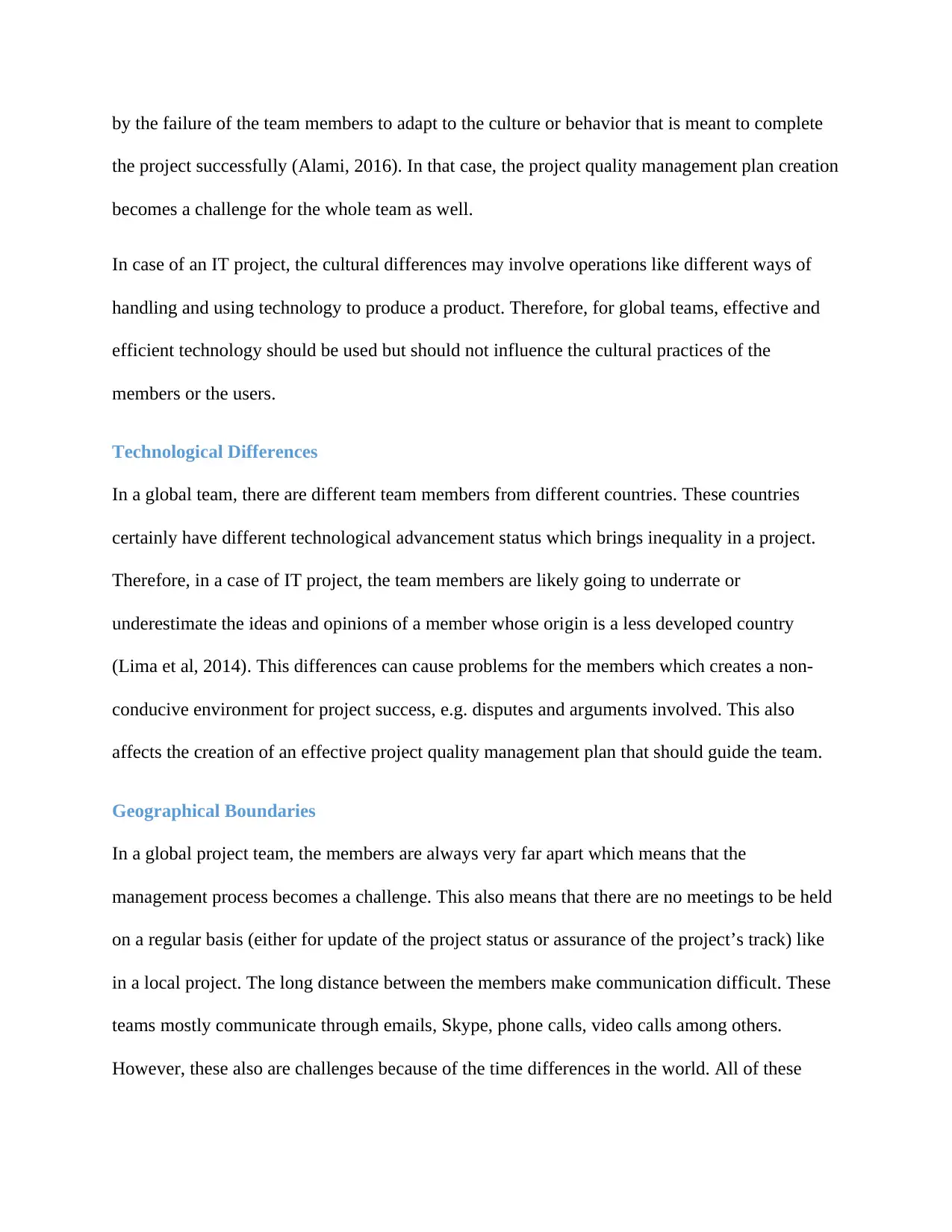
by the failure of the team members to adapt to the culture or behavior that is meant to complete
the project successfully (Alami, 2016). In that case, the project quality management plan creation
becomes a challenge for the whole team as well.
In case of an IT project, the cultural differences may involve operations like different ways of
handling and using technology to produce a product. Therefore, for global teams, effective and
efficient technology should be used but should not influence the cultural practices of the
members or the users.
Technological Differences
In a global team, there are different team members from different countries. These countries
certainly have different technological advancement status which brings inequality in a project.
Therefore, in a case of IT project, the team members are likely going to underrate or
underestimate the ideas and opinions of a member whose origin is a less developed country
(Lima et al, 2014). This differences can cause problems for the members which creates a non-
conducive environment for project success, e.g. disputes and arguments involved. This also
affects the creation of an effective project quality management plan that should guide the team.
Geographical Boundaries
In a global project team, the members are always very far apart which means that the
management process becomes a challenge. This also means that there are no meetings to be held
on a regular basis (either for update of the project status or assurance of the project’s track) like
in a local project. The long distance between the members make communication difficult. These
teams mostly communicate through emails, Skype, phone calls, video calls among others.
However, these also are challenges because of the time differences in the world. All of these
the project successfully (Alami, 2016). In that case, the project quality management plan creation
becomes a challenge for the whole team as well.
In case of an IT project, the cultural differences may involve operations like different ways of
handling and using technology to produce a product. Therefore, for global teams, effective and
efficient technology should be used but should not influence the cultural practices of the
members or the users.
Technological Differences
In a global team, there are different team members from different countries. These countries
certainly have different technological advancement status which brings inequality in a project.
Therefore, in a case of IT project, the team members are likely going to underrate or
underestimate the ideas and opinions of a member whose origin is a less developed country
(Lima et al, 2014). This differences can cause problems for the members which creates a non-
conducive environment for project success, e.g. disputes and arguments involved. This also
affects the creation of an effective project quality management plan that should guide the team.
Geographical Boundaries
In a global project team, the members are always very far apart which means that the
management process becomes a challenge. This also means that there are no meetings to be held
on a regular basis (either for update of the project status or assurance of the project’s track) like
in a local project. The long distance between the members make communication difficult. These
teams mostly communicate through emails, Skype, phone calls, video calls among others.
However, these also are challenges because of the time differences in the world. All of these
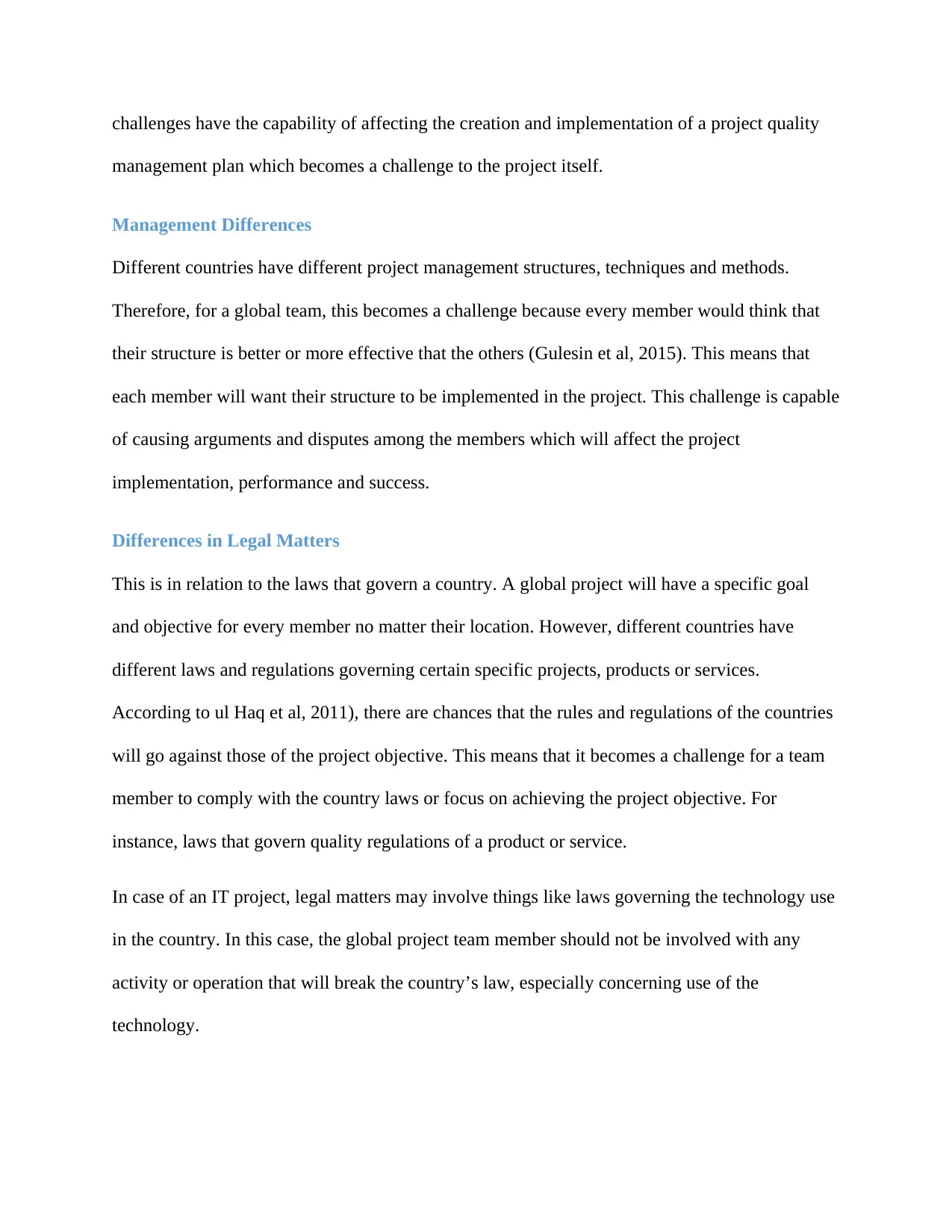
challenges have the capability of affecting the creation and implementation of a project quality
management plan which becomes a challenge to the project itself.
Management Differences
Different countries have different project management structures, techniques and methods.
Therefore, for a global team, this becomes a challenge because every member would think that
their structure is better or more effective that the others (Gulesin et al, 2015). This means that
each member will want their structure to be implemented in the project. This challenge is capable
of causing arguments and disputes among the members which will affect the project
implementation, performance and success.
Differences in Legal Matters
This is in relation to the laws that govern a country. A global project will have a specific goal
and objective for every member no matter their location. However, different countries have
different laws and regulations governing certain specific projects, products or services.
According to ul Haq et al, 2011), there are chances that the rules and regulations of the countries
will go against those of the project objective. This means that it becomes a challenge for a team
member to comply with the country laws or focus on achieving the project objective. For
instance, laws that govern quality regulations of a product or service.
In case of an IT project, legal matters may involve things like laws governing the technology use
in the country. In this case, the global project team member should not be involved with any
activity or operation that will break the country’s law, especially concerning use of the
technology.
management plan which becomes a challenge to the project itself.
Management Differences
Different countries have different project management structures, techniques and methods.
Therefore, for a global team, this becomes a challenge because every member would think that
their structure is better or more effective that the others (Gulesin et al, 2015). This means that
each member will want their structure to be implemented in the project. This challenge is capable
of causing arguments and disputes among the members which will affect the project
implementation, performance and success.
Differences in Legal Matters
This is in relation to the laws that govern a country. A global project will have a specific goal
and objective for every member no matter their location. However, different countries have
different laws and regulations governing certain specific projects, products or services.
According to ul Haq et al, 2011), there are chances that the rules and regulations of the countries
will go against those of the project objective. This means that it becomes a challenge for a team
member to comply with the country laws or focus on achieving the project objective. For
instance, laws that govern quality regulations of a product or service.
In case of an IT project, legal matters may involve things like laws governing the technology use
in the country. In this case, the global project team member should not be involved with any
activity or operation that will break the country’s law, especially concerning use of the
technology.
⊘ This is a preview!⊘
Do you want full access?
Subscribe today to unlock all pages.

Trusted by 1+ million students worldwide
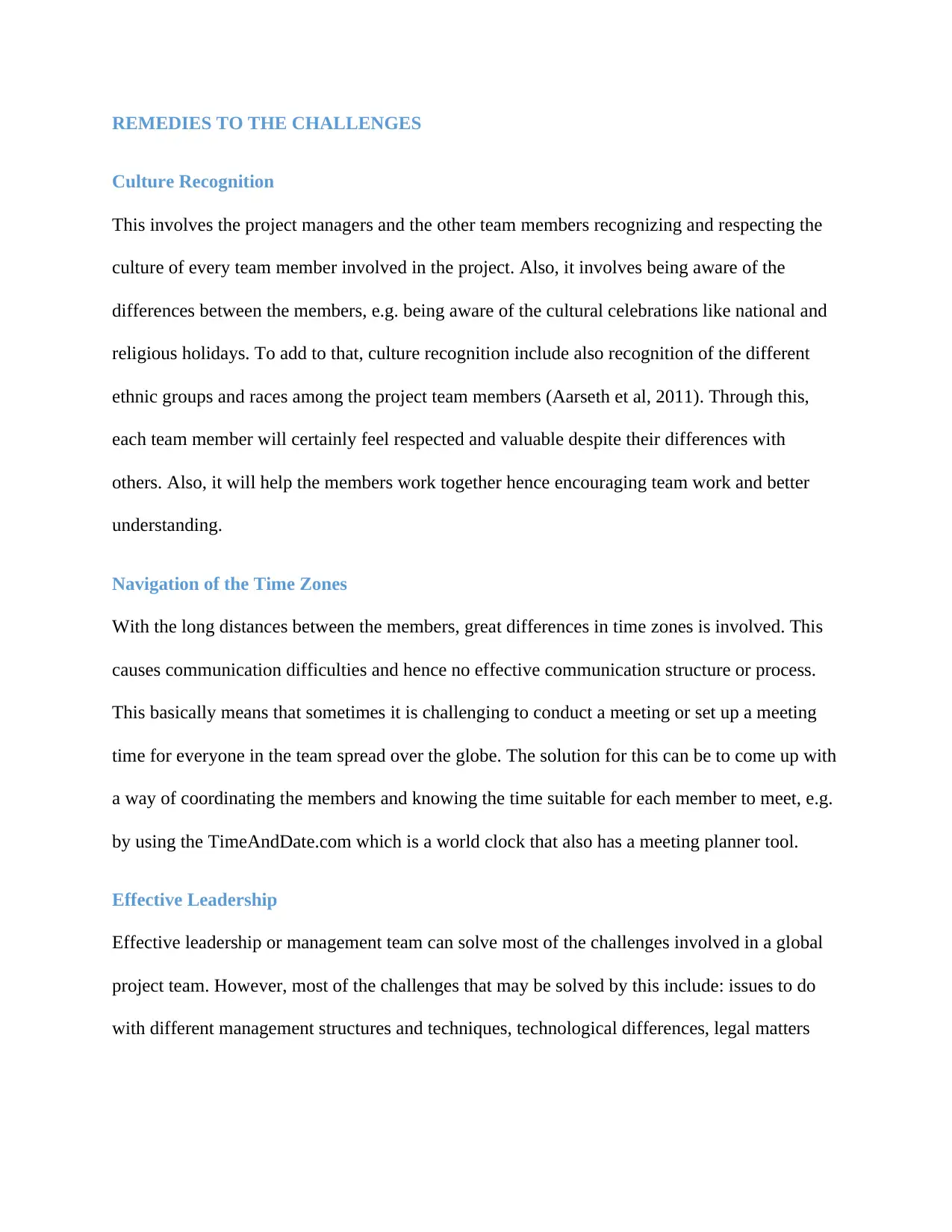
REMEDIES TO THE CHALLENGES
Culture Recognition
This involves the project managers and the other team members recognizing and respecting the
culture of every team member involved in the project. Also, it involves being aware of the
differences between the members, e.g. being aware of the cultural celebrations like national and
religious holidays. To add to that, culture recognition include also recognition of the different
ethnic groups and races among the project team members (Aarseth et al, 2011). Through this,
each team member will certainly feel respected and valuable despite their differences with
others. Also, it will help the members work together hence encouraging team work and better
understanding.
Navigation of the Time Zones
With the long distances between the members, great differences in time zones is involved. This
causes communication difficulties and hence no effective communication structure or process.
This basically means that sometimes it is challenging to conduct a meeting or set up a meeting
time for everyone in the team spread over the globe. The solution for this can be to come up with
a way of coordinating the members and knowing the time suitable for each member to meet, e.g.
by using the TimeAndDate.com which is a world clock that also has a meeting planner tool.
Effective Leadership
Effective leadership or management team can solve most of the challenges involved in a global
project team. However, most of the challenges that may be solved by this include: issues to do
with different management structures and techniques, technological differences, legal matters
Culture Recognition
This involves the project managers and the other team members recognizing and respecting the
culture of every team member involved in the project. Also, it involves being aware of the
differences between the members, e.g. being aware of the cultural celebrations like national and
religious holidays. To add to that, culture recognition include also recognition of the different
ethnic groups and races among the project team members (Aarseth et al, 2011). Through this,
each team member will certainly feel respected and valuable despite their differences with
others. Also, it will help the members work together hence encouraging team work and better
understanding.
Navigation of the Time Zones
With the long distances between the members, great differences in time zones is involved. This
causes communication difficulties and hence no effective communication structure or process.
This basically means that sometimes it is challenging to conduct a meeting or set up a meeting
time for everyone in the team spread over the globe. The solution for this can be to come up with
a way of coordinating the members and knowing the time suitable for each member to meet, e.g.
by using the TimeAndDate.com which is a world clock that also has a meeting planner tool.
Effective Leadership
Effective leadership or management team can solve most of the challenges involved in a global
project team. However, most of the challenges that may be solved by this include: issues to do
with different management structures and techniques, technological differences, legal matters
Paraphrase This Document
Need a fresh take? Get an instant paraphrase of this document with our AI Paraphraser
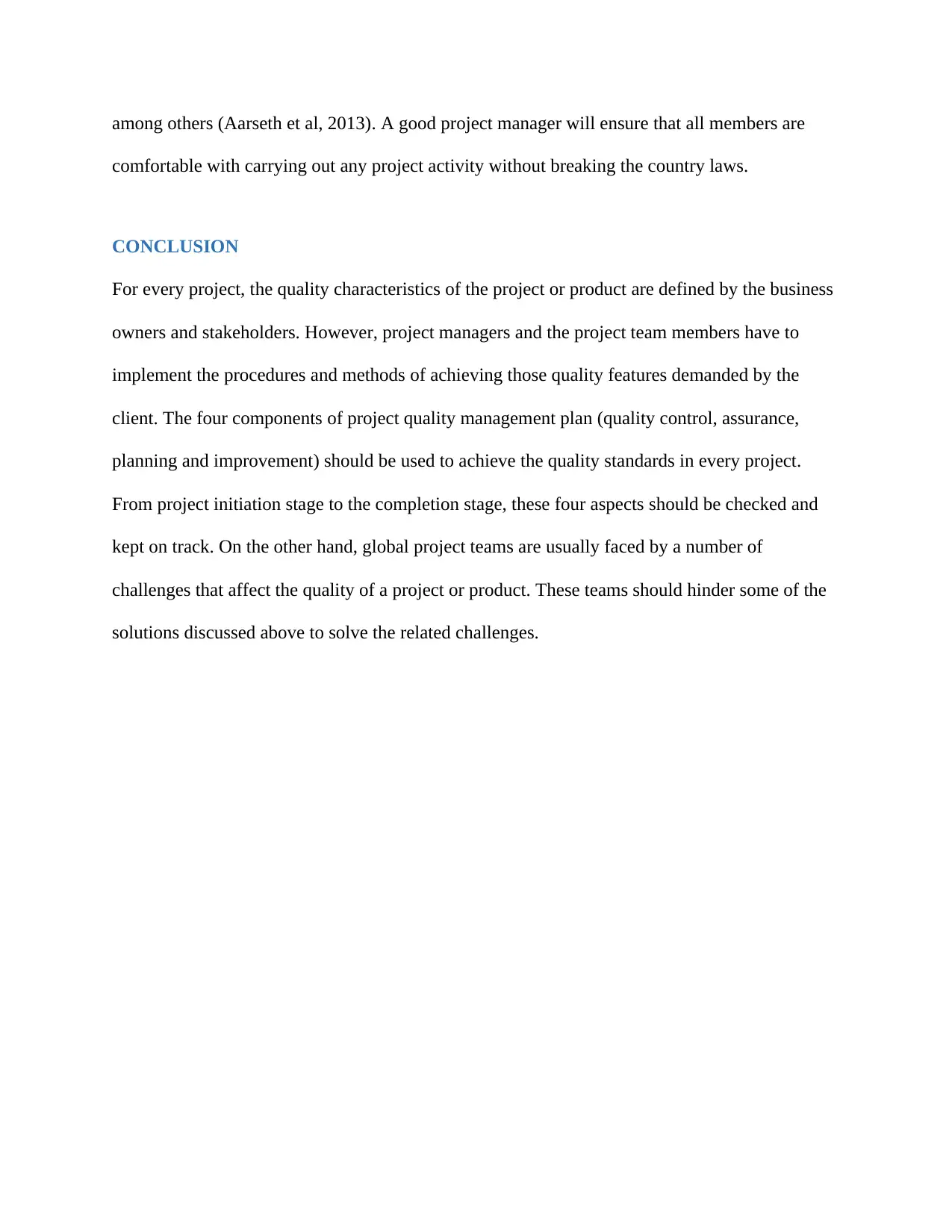
among others (Aarseth et al, 2013). A good project manager will ensure that all members are
comfortable with carrying out any project activity without breaking the country laws.
CONCLUSION
For every project, the quality characteristics of the project or product are defined by the business
owners and stakeholders. However, project managers and the project team members have to
implement the procedures and methods of achieving those quality features demanded by the
client. The four components of project quality management plan (quality control, assurance,
planning and improvement) should be used to achieve the quality standards in every project.
From project initiation stage to the completion stage, these four aspects should be checked and
kept on track. On the other hand, global project teams are usually faced by a number of
challenges that affect the quality of a project or product. These teams should hinder some of the
solutions discussed above to solve the related challenges.
comfortable with carrying out any project activity without breaking the country laws.
CONCLUSION
For every project, the quality characteristics of the project or product are defined by the business
owners and stakeholders. However, project managers and the project team members have to
implement the procedures and methods of achieving those quality features demanded by the
client. The four components of project quality management plan (quality control, assurance,
planning and improvement) should be used to achieve the quality standards in every project.
From project initiation stage to the completion stage, these four aspects should be checked and
kept on track. On the other hand, global project teams are usually faced by a number of
challenges that affect the quality of a project or product. These teams should hinder some of the
solutions discussed above to solve the related challenges.
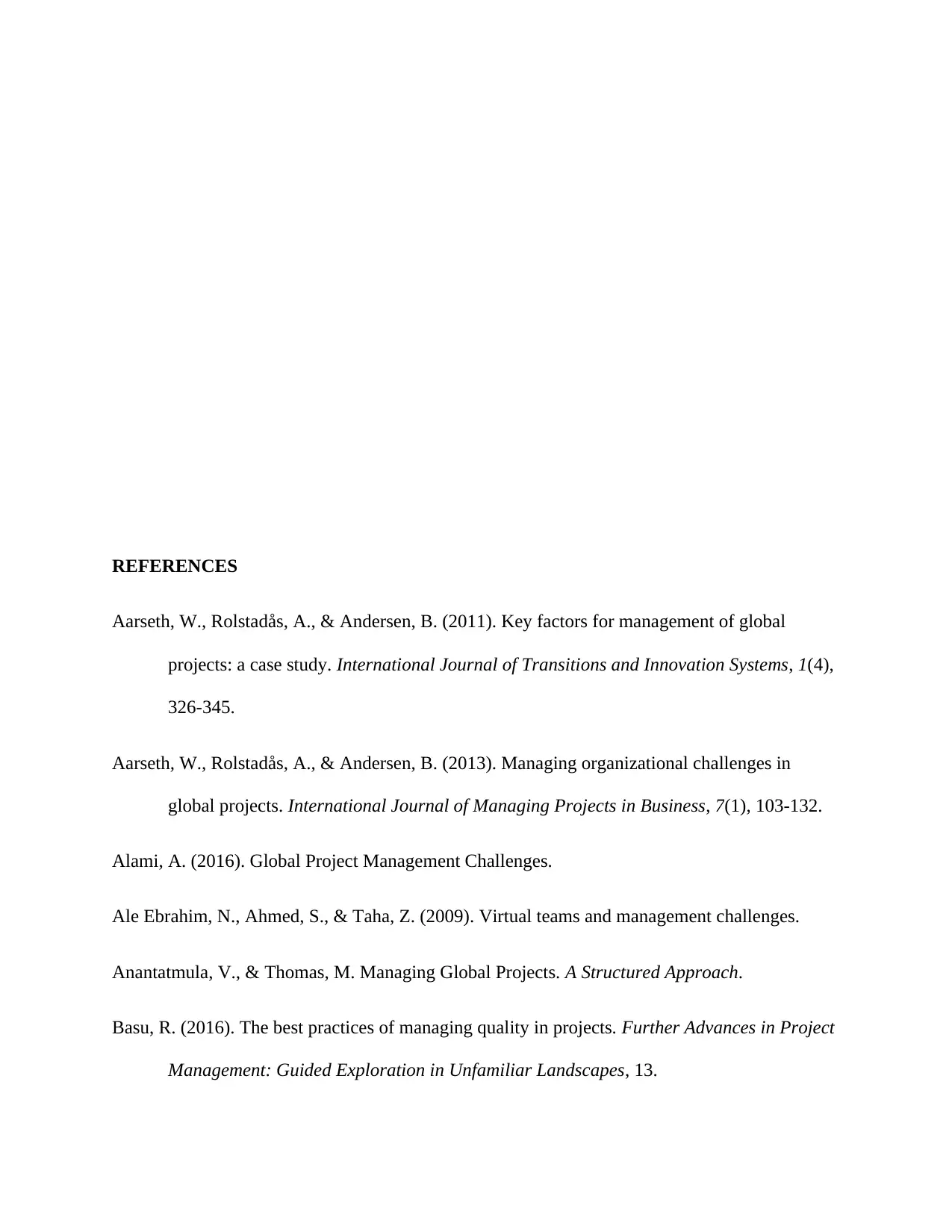
REFERENCES
Aarseth, W., Rolstadås, A., & Andersen, B. (2011). Key factors for management of global
projects: a case study. International Journal of Transitions and Innovation Systems, 1(4),
326-345.
Aarseth, W., Rolstadås, A., & Andersen, B. (2013). Managing organizational challenges in
global projects. International Journal of Managing Projects in Business, 7(1), 103-132.
Alami, A. (2016). Global Project Management Challenges.
Ale Ebrahim, N., Ahmed, S., & Taha, Z. (2009). Virtual teams and management challenges.
Anantatmula, V., & Thomas, M. Managing Global Projects. A Structured Approach.
Basu, R. (2016). The best practices of managing quality in projects. Further Advances in Project
Management: Guided Exploration in Unfamiliar Landscapes, 13.
Aarseth, W., Rolstadås, A., & Andersen, B. (2011). Key factors for management of global
projects: a case study. International Journal of Transitions and Innovation Systems, 1(4),
326-345.
Aarseth, W., Rolstadås, A., & Andersen, B. (2013). Managing organizational challenges in
global projects. International Journal of Managing Projects in Business, 7(1), 103-132.
Alami, A. (2016). Global Project Management Challenges.
Ale Ebrahim, N., Ahmed, S., & Taha, Z. (2009). Virtual teams and management challenges.
Anantatmula, V., & Thomas, M. Managing Global Projects. A Structured Approach.
Basu, R. (2016). The best practices of managing quality in projects. Further Advances in Project
Management: Guided Exploration in Unfamiliar Landscapes, 13.
⊘ This is a preview!⊘
Do you want full access?
Subscribe today to unlock all pages.

Trusted by 1+ million students worldwide
1 out of 14
Related Documents
Your All-in-One AI-Powered Toolkit for Academic Success.
+13062052269
info@desklib.com
Available 24*7 on WhatsApp / Email
![[object Object]](/_next/static/media/star-bottom.7253800d.svg)
Unlock your academic potential
Copyright © 2020–2025 A2Z Services. All Rights Reserved. Developed and managed by ZUCOL.




